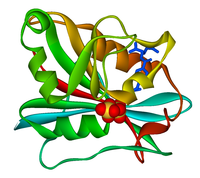
Photo from wikipedia
Abstract Methotrexate is a widely used anti-metabolite in cancer chemotherapy. A series of halogenated drugs is designed from Methotrexate to assess their interactions with human dihydrofolate reductase. The aim of… Click to show full abstract
Abstract Methotrexate is a widely used anti-metabolite in cancer chemotherapy. A series of halogenated drugs is designed from Methotrexate to assess their interactions with human dihydrofolate reductase. The aim of this study is to evaluate the performance of the modified drugs compared to the parent Methotrexate. Density Functional Theory is employed to optimize these drugs. Molecular docking calculation of these optimized drugs against dihydrofolate reductase is performed to find out binding affinity. In addition, molecular dynamics simulation is considered for the complexes of best two modified drugs with their receptors. Modifications by the halogens show significant changes in the charge distribution, dipole moment, thermodynamic stability, enthalpy and free energy. The highest binding affinity value (−36.401 KJ/mol) was obtained for M14. Hybrid quantum mechanics/molecular mechanics calculation shows a binding energy of −255.140 KJ/mol. Modified drugs have significant hydrogen and non-covalent bonding interactions with amino acids of the receptor. Molecular dynamics simulation disclosed that the root-mean-square-deviation of the alpha carbon associated with M6-1KMV and M14-1KMV complexes is 2.367 Å and 2.622 Å, respectively. Moreover, the interactions between modified drugs and receptor are mostly persevered in 25 nanosecond molecular dynamics simulation. Ensemble-based docking also confirmed that modified drugs show strong non-bonding interactions with different crystallographic and molecular dynamics based conformers. The best scored drugs show considerable pharmacokinetic properties. Modified derivatives M5, M6, M8, M10, M13 and M14 show the better binding affinity and a good number of hydrogen and other non-bonding interactions with the target protein which are similar to other anticancer drugs. Communicated by Ramaswamy H. Sarma
Journal Title: Journal of Biomolecular Structure and Dynamics
Year Published: 2019
Link to full text (if available)
Share on Social Media: Sign Up to like & get
recommendations!